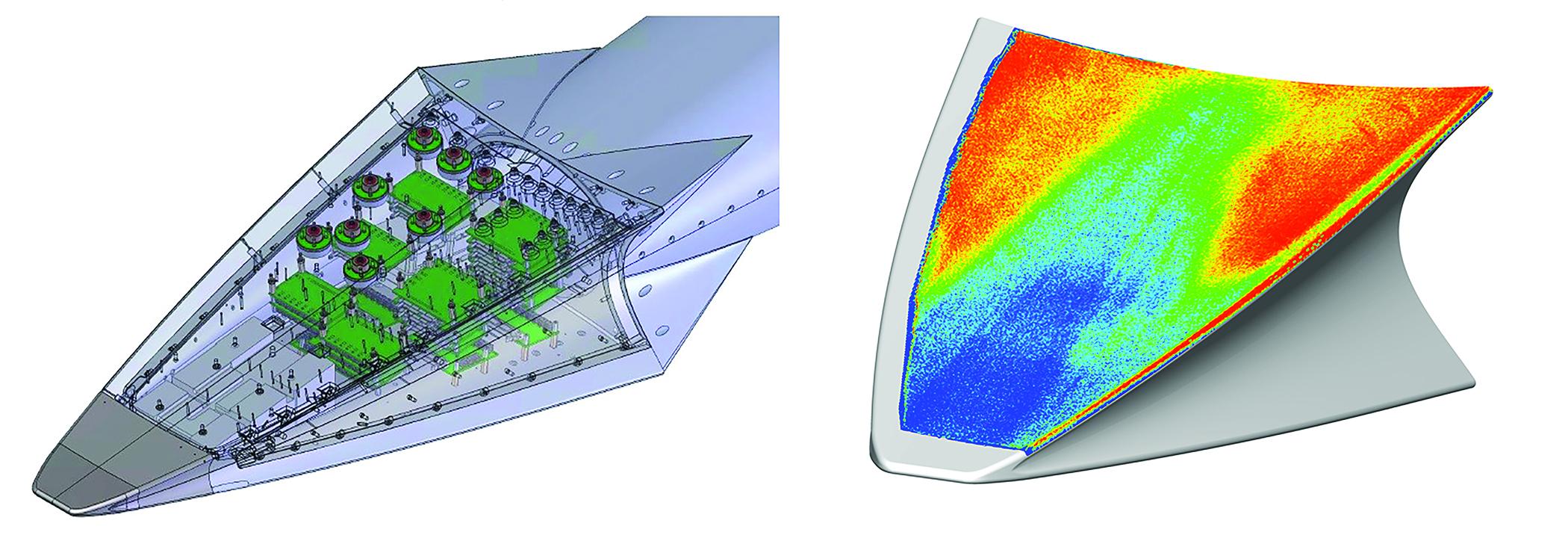高超声速飞行测试准备工作加速 | Hypersonic Flight Testing Preparations Ramp Up

尽管最近政府、学术界和工业界的地面测试设施都得到了更多的投资,但测试能力仍然是美国高超声速开发人员的主要挑战,特别是那些希望生产下一代大型飞行器的开发人员。
Testing remains a key challenge for U.S. hypersonic developers, particularly those looking to produce the next generation of larger vehicles, despite a recent wave of reinvestment in government, academic and industrial ground-test facilities.
“我们无法在我想要的所有条件下进行测试,”洛克希德·马丁公司导弹与火控技术总监David Hunn于2019年11月在伦敦举行的皇家航空学会高超声速会议上表示。进行高超声速飞行器测试需要评估焓、热通量、压力和氧气含量这四个条件,但是目前没有可以同时评估这四个条件的测试场所可供美国开发人员使用。因此,更多精力不可避免地被放在对已有飞行器的飞行测试上,并且将地面测试并设计不确定性余量为补充。
“We can’t test at all the conditions I want,” said David Hunn, director of technology at Lockheed Martin Missiles and Fire Control, speaking at a Royal Aeronautical Society hypersonics conference in London in November. Of the basic test conditions—enthalpy, heat flux, pressure and oxygen content—there is no test site open to U.S. developers where all four can be evaluated simultaneously. This inevitably puts a greater focus on flight tests for qualifying vehicles, backed up by ground tests and the addition of margin for uncertainties.
X-43A、X-51A和DARPA领导的HTV-2“猎鹰”高超声速飞行器已经产生了宝贵的数据,因此Hunn称它们为“空中风洞”。例如,在2010年和2011年测试的HTV-2飞行器,在它再入时在16马赫的速度下产生了540秒的数据。Hunn表示这些飞行测试十分重要,这些飞行器在它们退役前取得了“非常有趣”的空气动力和材料数据。
The “wind tunnels in the sky,” as Hunn described previous U.S. tests such as the X-43A, X-51A and DARPA-led HTV-2 Falcon, have produced invaluable data. The HTV-2 reentry vehicles, for example, tested in 2010 and 2011, generated 540 sec. of data at around Mach 16. “We got very interesting aerodynamic and materials data on those vehicles before they came to their untimely end,” he said.
美国空军研究实验室(AFRL)的X-60A是一款近期内就可以进行测试的高超声速飞行平台,它是一款从空中发射的液氧/煤油动力火箭,旨在以5~8马赫的飞行条件下测试有效载荷。这种可消耗的飞行器将从一架改装过的“湾流”公务机上面进行发射,它装有机翼以提高机动性,并且装有机载遥测系统以捕获数据。X-60A由AFRL和时代轨道”发射服务公司(Generation Orbit Launch Services)共同开发,目前计划于2021年春季在佛罗里达进行首次试飞。
A flying testbed planned for the near term is the U.S. Air Force Research Laboratory’s (AFRL) X-60A, an air-launched liquid oxygen/kerosene-powered rocket that is designed to test payloads at hypersonic speeds from Mach 5-8. The expendable vehicle, which will be dropped from a modified Gulfstream business aircraft, is configured with wings for maneuverability and an onboard flight telemetry system for data capture. Developed by Generation Orbit Launch Services, the X-60A is now expected to make its initial test flight out of Cecil Spaceport, Jacksonville, Florida, in spring 2021.
另外,AFRL还有一次即将到来的高超声速飞行测试,这次测试由约翰·霍普金斯大学应用物理实验室领导,该飞行测试是飞行器附面层过渡(BOLT)试验。测试载荷由火箭发射,旨在评估复杂几何形状表面的空气流动特性。此前,美国-澳大利亚的团队成功进行了一系列HIFiRE飞行测试,本次飞行测试建立在这些成功测试的基础上,将测量更大后掠角前缘的低曲率表面的附面层转化,这样的外形更接近未来更大的飞行器。
Another impending AFRL hypersonic flight test, this time led by the Johns Hopkins University Applied Physics Laboratory, is the Boundary Layer Transition (BOLT) flight experiment—a rocket-launched payload designed to evaluate flow characteristics over complex geometries. Building on the results of earlier tests as part of the successful U.S.-Australian HIFiRE flight series, the experiment will measure boundary-layer transition on a low-curvature concave surface with highly swept leading edges—a shape more relevant to future large-scale vehicles.
这次飞行测试过程中,测试载荷由探空火箭将其携带到高度超过280千米,装备有BOLT测试仪器的有效载荷将在爬升时达到4.7~6马赫,而在下降阶段的最后几秒钟可以达到6.7~7.4马赫。在15 千米的高度上,该有效载荷将与助推器分开,它将进入平旋减速状态,以降低着陆时的接地速度,在回收后不至于受严重破坏可以重复使用。而由于新冠病毒流行的影响,该试验已从5月推迟到8月,后备发射日期为2021年初。试验将在瑞典航天公司的Esrange航天中心进行。
Boosted by a sounding rocket to just over 280 km (174 mi.) altitude, the heavily instrumented BOLT payload will conduct the first experiment on ascent between Mach 4.7-6, and in the final few seconds of descent, between Mach 6.7-7.4. At an altitude of 15 km the payload will be separated from the booster to allow it to enter a flat spin—slowing its velocity before impact and enabling it to be inspected after recovery. The test, which was delayed from May by the COVID-19 pandemic, has been rescheduled for August with a backup date in early 2021. It will be conducted at the Swedish Space Corporation’s Esrange near Kiruna, Sweden.
随着美国加速对高超声速滑翔飞行器和巡航导弹进行飞行测试,仅美国空军就计划在未来四年内进行40次单独发射测试,而私营企业正加紧努力介入竞争。例如Stratolaunch公司已经阐述了他们了计划,其用于空射中型火箭的大型载机将改装用于支持高超声速发射试验的平台。
As flight tests of initial hypersonic glide vehicles and cruise missiles accelerate in the U.S., with 40 individual launches planned over the next four years by the Air Force alone, private industry is stepping up efforts to enter the fray. One company, Stratolaunch, has outlined plans to repurpose its huge carrier aircraft—originally designed to air-launch medium rockets—into a platform to support hypersonic flight tests.
Stratolaunch旨在于2020年晚些时候在其加利福尼亚州莫哈韦的基地恢复飞行测试,并计划从Talon-A开始研发一系列的飞行试验平台。Talon-A是一种完全可重复使用的、自主控制的液体火箭飞行器,预期飞行速度可达6马赫。接下来的计划是Talon-Z,其目标是在速度高达10马赫的测试条件下使用,该公司未来长期计划的目标是“黑冰”空天飞机。
Stratolaunch, which aims to resume flight tests at its Mojave, California, base later this year, plans a series of flying testbeds starting with the Talon-A, a fully reusable, autonomous, liquid rocket-powered vehicle targeted at flight speeds up to Mach 6. This will be followed by the Talon-Z, targeted at test conditions up to Mach 10, and the longer-term “Black Ice” spaceplane.
另一家私人企业,总部位于亚特兰大的Hermeus公司,已经完成了对涡轮基联合循环(TBCC)发动机原型机的扩展静态测试和高速试验室测试,测试速度高达5马赫,并且正在制定近期计划来测试发动机的工作模式。该公司的目标是基于身、材料、系统和推进系统的现有技术和短期内可达到技术的基础上,开发一种高速运输工具,以便在2020年代末实现服役。
Another private venture, Atlanta-based Hermeus, has completed scaled static and high-speed laboratory tests of a prototype turbine-based combined-cycle (TBCC) engine up to Mach 5, and is working on near-term plans to test the transition between engine modes. The company aims to develop a high-speed transport for entry into service around the end of this decade based on existing and near-term airframe, materials, systems and propulsion technologies.
同时,DARPA与美国空军正在对一款被称为“先进全范围发动机”(AFRE)的TBCC发动机系统的各个组件进行单独的地面测试。AFRE采用涡轮发动机和双模冲压/超燃冲压发机(DMRJ)组成,专为未来飞行速度高达5马赫的高超声速飞行器,这种飞行器可以从跑道水平起飞并重复使用。
DARPA, together with the Air Force, is meanwhile conducting individual ground tests of elements of a TBCC system called the Advanced Full-Range Engine (AFRE). Designed for future runway-based reusable hypersonic vehicles operating up to Mach 5, the AFRE combines an off-the-shelf turbine and dual-mode ramjet/scramjet (DMRJ).
发动机使用整体喷射预冷压缩机来进行冷却,来缩小涡轮发动机的最大速度和冲压发动机最小速度之间的过渡阶段。该预冷系统的核心部件是喷水系统组件,它与燃烧室、涡轮/DMRJ发动机的共用进气道和共用的喷嘴将于2020年晚些时候集成到完整的TBCC系统中。发动机的自由工作测试定于2021年进行。
The engine uses mass-injection precompressor cooling to close the gap between the maximum speed of the turbine and the takeover speed of the ramjet. The water injection element at the heart of this, together with the common turbine/DMRJ inlet, combustor and common nozzle will be integrated later this year into the complete TBCC assembly. Free-jet testing of the engine is set to occur in 2021.
NASA的长时间工作高超声速技术项目还继续研究TBCC的概念,并于6月宣布将与GE合作开发用于该发动机零部件的高温陶瓷基复合材料。NASA还选择了GE的F101发动机进行分析,作为TBCC发动机研究的一部分。
NASA’s long-running Hypersonic Technology Project also continues to study a TBCC concept, and in June announced it will work with GE Aviation to develop high-temperature ceramic matrix composite materials for component parts. NASA also selected GE’s F101 turbofan for analysis as part of studies of a TBCC-powered concept vehicle.
这条消息是Guy Norris在 Aviation Week & Space Technology 发表的文章。您可以点击此处查看更多关于高超音速的文章。



